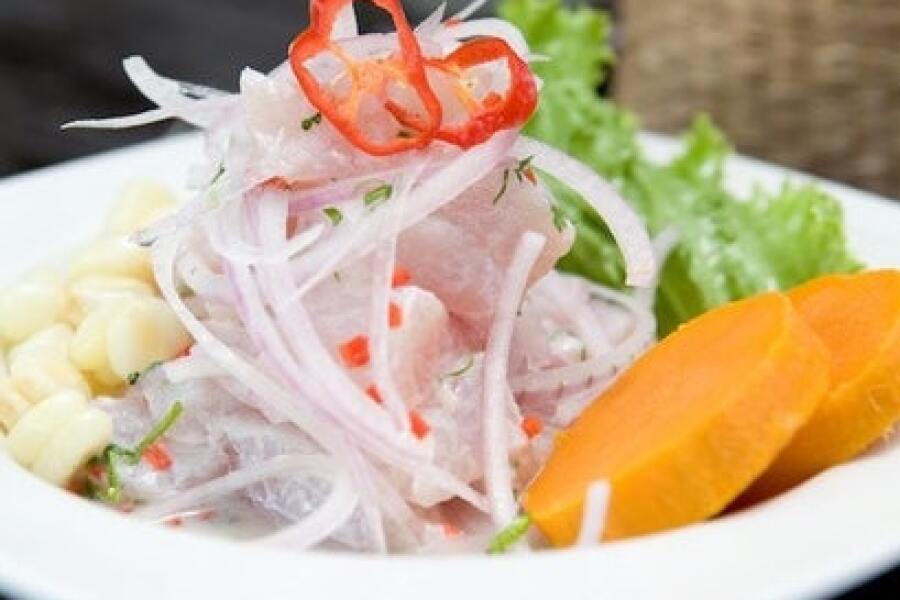In its most basic form, ceviche is nothing more than chunks of marinated seafood. But in Peru, one of the countries with a solid claim to being its birthplace, this simple preparation has emerged as the most important dish of an evolving cuisine.
In the capital city, Lima, diners value fresh ingredients and complex flavor combinations. They also celebrate innovative and artful chefs. The spirit of this culinary scene is embodied in a plate of Peruvian ceviche, which brings together a mix of bright tastes—notably the tang of lime and the sharp bite of ají limo (Peruvian chili)—with the contrasting textures of tender fish, sweet potato, and crunchy toasted corn.
“We think ceviche started in the north of Peru with the old Mochica culture [first to eighth centuries c.e.],” says Gastón Acurio, proprietor of La Mar Cebichería and Peru’s best-known chef. “It is a very old tradition for fishermen to take along a bit of salt and ají in the boat and eat the fresh fish at sea.”
But just as Peru’s culture is a blend of Inca, Spanish, African, Japanese, and other influences, ceviche is likewise a hybrid. Five hundred years ago, Spanish conquistadors brought limes and onions to the Southern Hemisphere, providing two fundamental elements for classic Peruvian ceviche. The raw fish was “cooked” for hours in lime juice with onion and ají limo, and its consistency changed as though the fish had been blanched in boiling water.
For centuries, after the day’s catch found its way to land, it was made into ceviche almost exclusively by fishermen’s wives. Outside the home, the dish was available only at market stalls in fishing villages. That began to change in the 1950s, when Japanese immigrants, whose ranks swelled after the initial arrivals in 1899, established Lima’s first cevicherías—small restaurants serving only ceviche. In the 1970s, the Lima metropolitan area expanded and absorbed fishing towns such as Callao and Chorrillos, and cevicherías proliferated. The Japanese custom of eating fish absolutely raw inspired Peruvians to try shorter marinade times, bringing them down to the half minute that is common today.
Ceviche remains a lunchtime staple in Peru—traditionalists would never dream of eating it past midafternoon, when the fish caught that morning is no longer considered fresh. Even for lunch, Lima’s fashionable restaurants have taken the dish to new heights. In 2005, Acurio opened La Mar, the first upscale cevichería, and accelerated Peru’s novoandina (New Andean) cuisine movement, which blends local ingredients and recipes with refined gastronomic techniques and concepts. Acurio has invented such bold ceviche combinations as ahi, cucumber, avocado, and tamarind; and mahimahi, peanuts, ginger, mango, and wonton strips. In the last five years, he has opened branches of La Mar Cebichería in eight Latin American cities outside Peru as well as in Madrid, San Francisco, and New York City. Acurio aspires to make Peruvian ceviche as well known across the globe as sushi.
How to Make Classic Peruvian Ceviche
(SERVES 4 AS AN APPETIZER)
Adapted from Gastón Acurio’s recipe served at La Mar Cebichería
Leche de Tigre Marinade
INGREDIENTS
- 1 cup freshly squeezed key lime juice
- 1⁄2 pound raw halibut fillet* 1 clove garlic
- 1 1⁄2 cups fish stock
- 1⁄2 habanero chili
- 1 sprig cilantro
- 1 stalk celery
- 1 medium white onion
MAKE IT: Thoroughly mix all the ingredients in a blender. Strain. Set the liquid aside.
Ceviche
INGREDIENTS
- 1 1⁄2 to 2 pounds raw halibut fillet*
- Salt to taste
- 1⁄2 habanero chili, finely diced
- 1 cup ice cubes
- 1 1⁄4 ounces red onion, finely sliced
- 1 1⁄2 ounces cooked choclo (large-kernel Peruvian corn) or yellow corn
- 1 ounce cooked sweet potato, cut into small cubes or circles
- 1 sprig cilantro or 1 lettuce leaf
MAKE IT
1. Chop halibut into 3⁄4-inch cubes. Place in a bowl.
2. Add salt, habanero chili, and ice cubes.
3. Add the leche de tigre marinade and stir.
4. Let the mixture set for 30 seconds and then remove the ice cubes.
5. Spoon the ceviche onto a plate, top with the onion, and garnish with the choclo, sweet potato, and cilantro or lettuce.
NOTE: Fish used to make ceviche must be perfectly fresh. If you didn’t catch it yourself or get it directly from someone who did, look for sushi-grade cuts. For health reasons, don’t attempt to make ceviche otherwise.
This article originally appeared online in May 2012; it was updated in December 2017 to include current information.
>>Next: Chefs Would Travel for These 4 Ingredients










